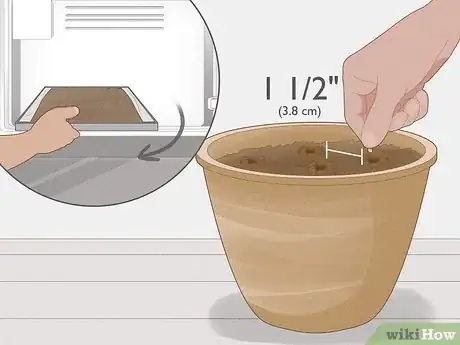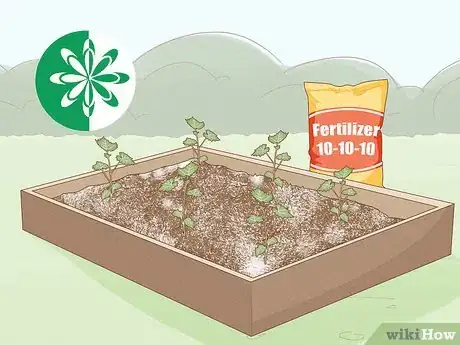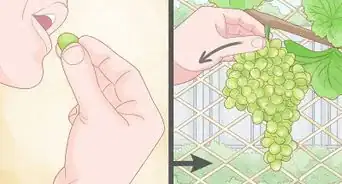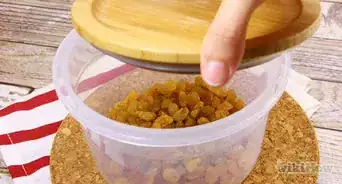This article was co-authored by Andrew Carberry, MPH. Andrew Carberry is a Food Systems Expert and the Senior Program Associate at the Wallace Centere at Winrock International in Little Rock, Arkansas. He has worked in food systems since 2008 and has experience working on farm-to-school projects, food safety programs, and working with local and state coalitions in Arkansas. He is a graduate of the College of William and Mary and holds a Masters degree in public health and nutrition from the University of Tennessee.
There are 9 references cited in this article, which can be found at the bottom of the page.
wikiHow marks an article as reader-approved once it receives enough positive feedback. This article received 19 testimonials and 90% of readers who voted found it helpful, earning it our reader-approved status.
This article has been viewed 764,851 times.
Have you ever wanted to grow your own grapes? Grapevines are both beautiful and useful, and are one of the oldest plants to be cultivated. Grapes are typically reproduced from cuttings or grafts; however, if you are determined (it's hard!) and patient (it takes a long time!), you can grow grapes from seeds. Read on to learn how to do it.
Steps
Selecting Your Grape Seeds
-
1Choose the right variety. There are thousands of grape varieties in the world. For the greatest success in growing grapes, choose the variety that will work best for you. Do some research on grape varieties, while keeping the following in mind:
- Your reasons for growing grapes. You may want to eat the fruit, make jam, make wine, or just add the beauty of grapevines to your yard. Find out which varieties are best for your intended purpose.
- Your climate conditions. Different varieties of grapes are better suited to certain geographic areas and climate conditions. Learn about grapes that are known to perform well in your area.
- Natural variation among grapes grown from seed. There are some genetic differences even among grapes of the same type, so the grapes you grow may not turn out exactly the way you expect. Go into your project with an open mind, and be prepared to experiment.
-
2Obtain the grape seeds. Once you identify the variety of grapes you want to grow, get your seeds. You can get them from grapes you've purchased, from a nursery, from your yard's wild grapevines (in some areas), or from another gardener.Advertisement
-
3Ensure the seeds are viable. Examine the seeds to make sure they are healthy and in good condition. Squeeze the seed gently between two fingers. A healthy seed is firm to the touch.[1]
- Look at the seed's color. In a healthy grape seed, you will be able to see a pale gray or white endosperm under the seed coat.
- Put them in water. Healthy, viable seeds will sink when placed in water. Discard any seeds that float.
Readying Your Seeds for Growth
-
1Prepare the seeds. Take the viable seeds and wash them thoroughly to remove any pulp or other matter. Soak them in a small amount of distilled water for up to 24 hours.[2]
-
2Stratify your seeds. Many seeds require a period of cold, moist conditions to begin the germination process. In nature, this is achieved when seeds sit in the ground over the winter. You can mimic these conditions through the process of stratification. For grape seeds, the best time to begin stratification is in December (the northern hemisphere winter).[3]
- Prepare a bed for your seeds. Fill an airtight bag or other capsule with a soft medium like wet paper towels or sand, vermiculite or peat moss that has been dampened. Peat moss is the best choice for grape seeds because its anti-fungal properties will help eliminate seed-damaging mold.
- Tuck the seeds into the bed. Cover them with about 1/2" (1.25 cm) of growing medium.
- Refrigerate the seeds. The ideal temperature for stratification is a steady 35-40 ºF (1-3 ºC), so the refrigerator is a good place for this process. Keep the seeds refrigerated for two to three months. Do not allow them to freeze.
-
3Plant your seeds. In early spring, remove the seeds from the refrigerator and plant them in pots filled with good soil. Plant seeds individually in small pots, or in larger pots with at least 1 1/2" (3.8 cm) between them.[4]
- Make sure your seeds stay warm enough. To properly germinate, the seeds need daytime temperatures of at least 70ºF (20ºC) and nighttime temperatures around 60ºF (15ºC). Use a greenhouse or warming mats to keep your seeds at the correct temperature.
- Keep the soil moist but not too wet. Mist the surface with a fine spray of water when it starts to look dry.
- Check for growth. Grape seeds typically take between 2-8 weeks to sprout.
-
4Transplant your seedlings. When your seedlings have grown to about 3" (8 cm), transplant them to 4" (10 cm) pots. For the healthiest plants, keep your seedlings indoors or in a greenhouse until they have reached a height of 12" (30 cm), have a good network of roots and have at least 5-6 leaves.
Moving Your Grapevines Outdoors
-
1Select a good location for your grapevines. To thrive, grapevines need the right amount of sun, proper drainage and a form of support.
- Choose a sunny spot. Grapes need 7-8 hours of full sun daily for best results.
- Make sure you have plenty of space. Space your plants about 8' (2.5 m) apart to allow for growth.
-
2Prepare your soil before planting. Grapes require well drained soil. If you have clay or other poorly drained soil, augment it with decomposed compost, sand or other soil amendments to increase drainage. Alternatively, use a raised bed filled with a good sandy loam mixed with compost.
- Check the pH of your soil before planting your grapes. Different types of grapes thrive best with different soil pH levels (5.5-6.0 for natives, 6.0-6.5 for hybrids, and 6.5-7.0 for vinifera), so it is best to either plant in an area with a pH level in the right range, or adjust your soil’s pH before planting.[5]
- If you are planning to grow grapes for wine, be aware that different types of soil (e.g., sandy, silty, rich in limestone, or rich in clay) will affect the flavor of the wine.[6]
-
3Fertilize your grapes after planting. Two weeks after planting, add a small amount of 10-10-10 fertilizer to the soil around the base of your young plants.[7] Repeat this process once per year every spring after that.
-
4Properly support your grapes. Grapevines need a trellis or arbor for proper support. The first year in the vineyard (2 years after starting from seed), when your plants are still small, stakes will be sufficient to support them and keep them off the ground. As they grow, you will need to train them to the trellis or arbor. Tie the tip of the shoots to the wire, and allow it to grow along the wire.[8]
-
5Take proper care of your plants, and prepare to wait. Grapevines take up to three years to start producing fruit. During that time, proper care and training of your plants is essential for the best fruit yield.[9]
- Year One: Watch for growth. Choose the strongest three shoots on the plant and allow those to grow. Pinch off all others. The three remaining shoots will grow stronger and more vigorous.
- Year Two: Fertilize using a balance fertilizer. Remove flower clusters as they emerge; allowing the vine to fruit this early will deplete its energy. Remove any buds or shoots that grow below the three main ones you selected the prior year. Prune properly. Loosely tie long shoots to the arbor or trellis.
- Year Three: Continue fertilizing and removing low buds and shoots. During this year, you can allow a few flower clusters to remain and produce a small crop of grapes.
- Year Four and Later: Continue fertilizing and pruning. This year and thereafter, you can let all the flower clusters fruit if you wish.
- As you prune, be aware that grapes will fruit on one-year-old wood (i.e., wood that grew during the previous season).
Expert Q&A
-
QuestionWhich pesticides can I use for grapes?
 Andrew Carberry, MPHAndrew Carberry is a Food Systems Expert and the Senior Program Associate at the Wallace Centere at Winrock International in Little Rock, Arkansas. He has worked in food systems since 2008 and has experience working on farm-to-school projects, food safety programs, and working with local and state coalitions in Arkansas. He is a graduate of the College of William and Mary and holds a Masters degree in public health and nutrition from the University of Tennessee.
Andrew Carberry, MPHAndrew Carberry is a Food Systems Expert and the Senior Program Associate at the Wallace Centere at Winrock International in Little Rock, Arkansas. He has worked in food systems since 2008 and has experience working on farm-to-school projects, food safety programs, and working with local and state coalitions in Arkansas. He is a graduate of the College of William and Mary and holds a Masters degree in public health and nutrition from the University of Tennessee.
Food Systems Expert The best solution is to attract predator insects to your area. Plant rows of flowers along the borders of your property and near grape vines to attract beneficial insects. If you still encounter problems, a mild mixture of soap and water sprayed on the leaves can take care of aphids and spider mites.
The best solution is to attract predator insects to your area. Plant rows of flowers along the borders of your property and near grape vines to attract beneficial insects. If you still encounter problems, a mild mixture of soap and water sprayed on the leaves can take care of aphids and spider mites. -
QuestionWhen are grape seeds planted?
 Community AnswerThey're commonly planted in the winter but are transplanted in the spring.
Community AnswerThey're commonly planted in the winter but are transplanted in the spring. -
QuestionWhich type of soil is suitable for grapes cultivation?
 Community AnswerIt depends on your grape type. If you are buying from a garden center/plant nursery, they will be able to advise you on what is suitable for your soil type and needs (size/color/flavor; eating or for wine).
Community AnswerIt depends on your grape type. If you are buying from a garden center/plant nursery, they will be able to advise you on what is suitable for your soil type and needs (size/color/flavor; eating or for wine).
References
- ↑ http://www.hortmag.com/weekly-tips/propagation/how-to-know-if-garden-seed-is-viable
- ↑ http://www.finegardening.com/jump-start-your-seeds
- ↑ http://www.hort.cornell.edu/reisch/grapegenetics/breeding/crossing3.html
- ↑ https://www.planetnatural.com/growing-grapes/
- ↑ http://www.growingproduce.com/fruits/commentary-how-soil-ph-influences-grapes/
- ↑ https://winefolly.com/deep-dive/introduction-soil-types-wine/
- ↑ https://www.arborday.org/trees/fruit/care-grape.cfm
- ↑ https://extension.umaine.edu/highmoor/research/growing-grapes-in-maine/
- ↑ http://www.extension.umn.edu/garden/yard-garden/fruit/growing-grapes-for-home-use/
About This Article
To grow grapes from seeds, start by soaking the seeds in water for 24 hours. Then, put them in a plastic bag with damp paper towels and leave them in the refrigerator for 3 months. In the early spring, plant the seeds in small pots and give them up to 8 weeks to sprout. Once the seedlings are 12 inches tall, plant them in a well-drained spot that gets 8 hours of sun daily. Two weeks after planting outside, add a small amount of 10-10-10 fertilizer to keep the plants healthy and help them grow. For tips from our Gardening reviewer on how to support your grapes with a trellis as they grow, read on!











































































